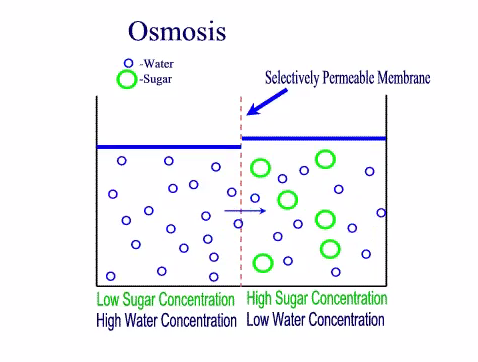Osmosis is defined as the process by which water moves from a region of high water potential to a region of low water potential, through a semi permeable membrane. This process takes place in all living cells. In most cases, osmosis takes place as a nutrient rich liquid permeates the cell membrane and moves towards the inside of the cell where the concentration of the solute is higher due to the inner cell anatomy, which consists of a variety of organelles that perform various functions that are necessary to keep the cell, and hence the organism, alive and functioning. Osmosis allows the nutrients needed by the cells to keep functioning reach the inside of the cell and get absorbed.

Serves a twofold purpose
Osmosis basically carries out a twofold role in the system of any living organism, plant and animal. One the one hand, it helps in the maintenance of a stable environment within a living being by balancing the pressures of the intercellar and intracellar fluids. On the other, it also helps the cells to absorb the nutrients carried from outside and expel cellular waste from the various bodily functions.
Maintains optimal concentration of solution
One of the most important functions of osmosis is the maintenance of the correct and most optimal concentration of solution inside the cell. This process helps to balance the concentration and pressure of the solution both inside and outside the cell bordered by a partially permeable membrane. This is achieved by ensuring that the water molecules are transported from the region of high water concentration to a region of low water concentration by moving through the boundary of partially absorbent material that forms the barrier between the two sides.
Helps in cellular waste removal
The process of osmosis is undertaken not just for the absorption of nutrients, but also for the process of waste removal. There are two trash processors within a cell- proteasome and lysosome. These work on unnecessary and damaged proteins (proteins are the building blocks of most organisms) as well as damaged ad unnecessary bits of organelles. The unwanted proteins are broken down by the proteasomes into even smaller bits that can be reused by the cell. The bits that are rendered completely unusable are discarded and expelled from the cell through the semi permeable membrane as cellular waste.
Similarly, the used bits of organelles are also processed by the lysosomes in a function called autophagy. The waste generated from this process is again expelled from the cell. This expelling of waste is done through the process of osmosis. If unused bits cannot be expelled from the cells, it can lead to some rare and life threatening conditions.
Helps in blood purification
Osmosis helps in expelling waste not just at a cellular level, but also very much from on an organic level. Our kidneys use the process of osmosis to separate the waste products generated by our bodies. This is a process of blood purification in which the kidneys separate the waste and impurities, creating what we know as urine, and then passing it on to the bladder which then sends a signal to evacuate the waste from the system. Needless to say, blood impurities can cause a multitude of diseases, from the apparently minor dullness of skin to the more obviously serious organ failure.
Maintains optimal cellular pressure
Osmosis ensures that the pressures both inside and outside the cells are maintained. This is undertaken by ensuring that the fluid volume both inside and outside the cell is well maintained and kept the same. If the fluid volume outside of the cell becomes greater than the fluid volume inside the cell, it would create pressure on the cell from the outside, and thus lead the cell to collapse. On the other hand, if the fluid volume inside the cell is great than the fluid volume outside of it, that would cause the cell to become turgid, and eventually explode as the pressure within increases. Both these cases would severely impede the normal functioning of a cell, and can lead to a variety of severe illnesses in both plants and animals.
Helps in absorption of nutrients
Osmosis is the process through which plants absorb moisture and nutrients from the soil in order to grow. This process involves gathering moisture and nutrients from the soil and carrying them upwards to the leaves. The leaves process these raw materials via photosynthesis and turns them into nutrients that the plant body is able to absorb and process. This actually has a far reaching ecological effect; if the process of osmosis had not been present, it would not be possible for any plant to grow on the surface of the earth. In turn, no other form of life would have been able to come into existence, and the earth as we know it today would not be there at all.
Also read: Importance of Fermentation
Osmosis performs very basic functions on a cellular and organic level, but these functions are important for the very survival of the plant and animal species of the world and thus maintain a healthy ecosystem. This transfer of nutrients and waste carried out by the cells through osmosis also requires a very minimal number of energy units because no force is required for osmosis. This ensures that all the energy that the cells produce can be used for the performance of other, highly complex biological functions.